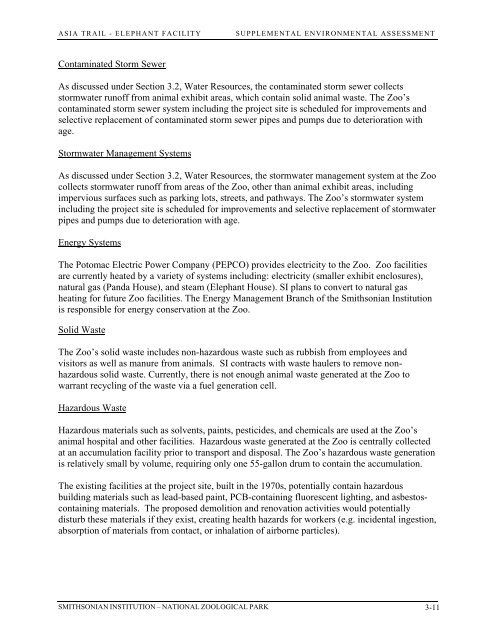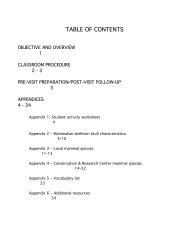asia trail elephant facility - National Zoo - Smithsonian Institution
asia trail elephant facility - National Zoo - Smithsonian Institution
asia trail elephant facility - National Zoo - Smithsonian Institution
Create successful ePaper yourself
Turn your PDF publications into a flip-book with our unique Google optimized e-Paper software.
ASIA TRAIL - ELEPHANT FACILITY SUPPLEMENTAL ENVIRONMENTAL ASSESSMENT<br />
Contaminated Storm Sewer<br />
As discussed under Section 3.2, Water Resources, the contaminated storm sewer collects<br />
stormwater runoff from animal exhibit areas, which contain solid animal waste. The <strong>Zoo</strong>’s<br />
contaminated storm sewer system including the project site is scheduled for improvements and<br />
selective replacement of contaminated storm sewer pipes and pumps due to deterioration with<br />
age.<br />
Stormwater Management Systems<br />
As discussed under Section 3.2, Water Resources, the stormwater management system at the <strong>Zoo</strong><br />
collects stormwater runoff from areas of the <strong>Zoo</strong>, other than animal exhibit areas, including<br />
impervious surfaces such as parking lots, streets, and pathways. The <strong>Zoo</strong>’s stormwater system<br />
including the project site is scheduled for improvements and selective replacement of stormwater<br />
pipes and pumps due to deterioration with age.<br />
Energy Systems<br />
The Potomac Electric Power Company (PEPCO) provides electricity to the <strong>Zoo</strong>. <strong>Zoo</strong> facilities<br />
are currently heated by a variety of systems including: electricity (smaller exhibit enclosures),<br />
natural gas (Panda House), and steam (Elephant House). SI plans to convert to natural gas<br />
heating for future <strong>Zoo</strong> facilities. The Energy Management Branch of the <strong>Smithsonian</strong> <strong>Institution</strong><br />
is responsible for energy conservation at the <strong>Zoo</strong>.<br />
Solid Waste<br />
The <strong>Zoo</strong>’s solid waste includes non-hazardous waste such as rubbish from employees and<br />
visitors as well as manure from animals. SI contracts with waste haulers to remove nonhazardous<br />
solid waste. Currently, there is not enough animal waste generated at the <strong>Zoo</strong> to<br />
warrant recycling of the waste via a fuel generation cell.<br />
Hazardous Waste<br />
Hazardous materials such as solvents, paints, pesticides, and chemicals are used at the <strong>Zoo</strong>’s<br />
animal hospital and other facilities. Hazardous waste generated at the <strong>Zoo</strong> is centrally collected<br />
at an accumulation <strong>facility</strong> prior to transport and disposal. The <strong>Zoo</strong>’s hazardous waste generation<br />
is relatively small by volume, requiring only one 55-gallon drum to contain the accumulation.<br />
The existing facilities at the project site, built in the 1970s, potentially contain hazardous<br />
building materials such as lead-based paint, PCB-containing fluorescent lighting, and asbestoscontaining<br />
materials. The proposed demolition and renovation activities would potentially<br />
disturb these materials if they exist, creating health hazards for workers (e.g. incidental ingestion,<br />
absorption of materials from contact, or inhalation of airborne particles).<br />
SMITHSONIAN INSTITUTION – NATIONAL ZOOLOGICAL PARK 3-11
















